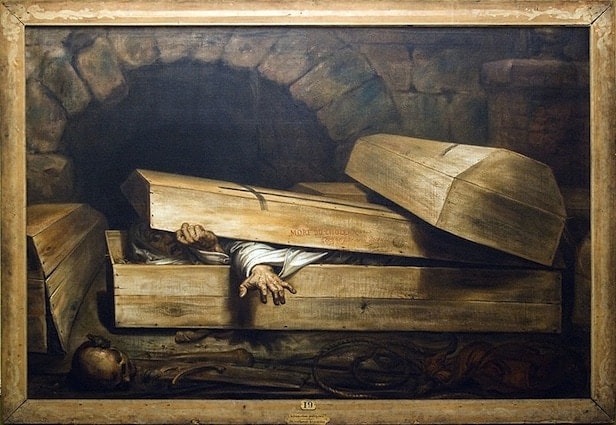People were buried alive so often in the 19th century that inventors patented safety coffins that would give the dead the ability to alert those above ground if they were still alive

People were buried alive so often in the 19th century that inventors patented safety coffins that would give the “dead” the ability to alert those above ground if they were still alive.

In the 19th century, a horrifying phenomenon plagued society - people being buried alive. Due to limited medical knowledge and the prevalence of mistaken pronouncements of death, countless individuals found themselves prematurely laid to rest. This grim reality spurred inventors to develop safety coffins designed to save the lives of those mistakenly declared dead. These fascinating inventions aimed to provide the buried with the means to alert those above ground if they were, in fact, still alive.
One must understand the prevailing conditions of the era to grasp the significance of safety coffins. In the 1800s, medical science lacked the sophistication it possesses today, leading to erroneous diagnoses of death. Methods used to confirm death were often crude and inadequate, such as observing for visible signs of life or relying on the absence of a pulse. As a result, numerous individuals were mistakenly pronounced dead and subsequently interred, only to wake up in their graves, desperate for rescue.
This frequent occurrence of premature burials prompted inventors to devise a range of ingenious safety coffins. One such example was the “coffin alarm.” This innovation included a series of strings attached to the buried person’s fingers or wrists, connected to a mechanism above ground. If the buried individual regained consciousness and moved, the pulling of the strings would activate a bell or some other signal, alerting those nearby to the terrifying situation.
:no_upscale()/cdn.vox-cdn.com/uploads/chorus_asset/file/3920998/1904coffinmorse.jpg)
Another well-known invention was the “safety coffin with breathing tubes.” This coffin featured a system of air pipes providing fresh air and, more importantly, a channel allowing communication between the buried individual and the surface. A rope connected to a bell would extend down to the buried person, enabling them to ring the bell if they woke up inside the coffin. This audible signal would immediately alert the outside world, providing a chance for rescue before it was too late.
The rising public concern regarding premature burials led to multiple patents being filed for various safety coffin designs. These inventions sought to address the terrifying possibility of being buried alive, bringing solace to individuals and their families who feared such a grisly fate. Although the success and adoption of these safety coffins remain unclear, their existence alone highlights the genuine fear that permeated society during the 19th century.
It is important to note that advancements in medical science, particularly the development of more accurate diagnostic methods, have significantly reduced the occurrence of premature burials. Today, the chances of mistakenly pronouncing someone dead are drastically lower compared to centuries past. However, the history of safety coffins serves as a somber reminder of the challenges faced by individuals in an era when medical knowledge was far from perfect.
Sources:
Tags
Share
Related Posts
Quick Links
Legal Stuff

